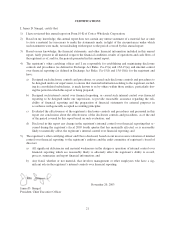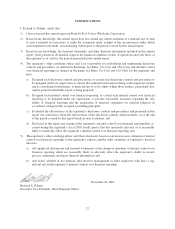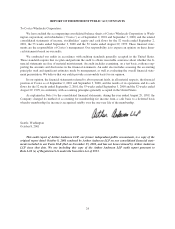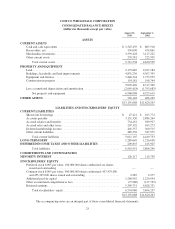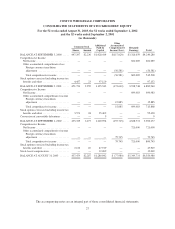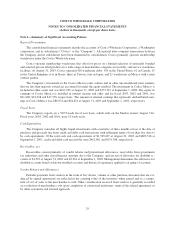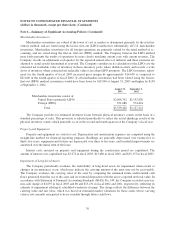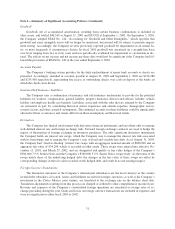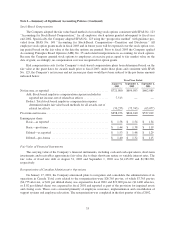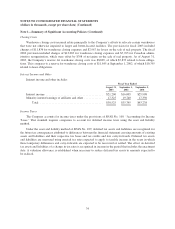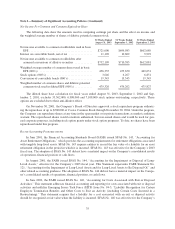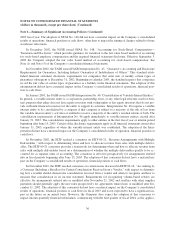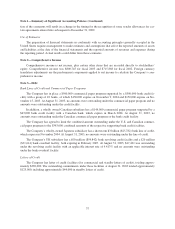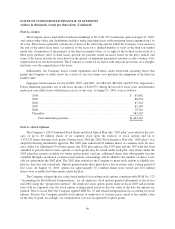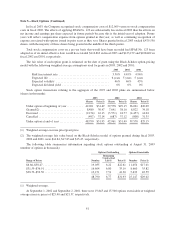Costco 2003 Annual Report Download - page 33
Download and view the complete annual report
Please find page 33 of the 2003 Costco annual report below. You can navigate through the pages in the report by either clicking on the pages listed below, or by using the keyword search tool below to find specific information within the annual report.Note 1—Summary of Significant Accounting Policies (Continued)
Goodwill
Goodwill, net of accumulated amortization, resulting from certain business combinations is included in
other assets, and totaled $46,549 at August 31, 2003 and $43,920 at September 1, 2002. On September 3, 2001,
the Company adopted SFAS No. 142, “Accounting for Goodwill and Other Intangibles,” which specifies that
goodwill and some intangible assets will no longer be amortized, but instead will be subject to periodic impair-
ment testing. Accordingly, the Company reviews previously reported goodwill for impairment on an annual ba-
sis, or more frequently if circumstances dictate. In fiscal 2001 goodwill was amortized on a straight-line basis
over lives ranging from two to forty years and was periodically evaluated for impairment as circumstances dic-
tated. The effects on net income and net income per share data would not be significant if the Company had fol-
lowed the provisions of SFAS No. 142 in the year ended September 2, 2001.
Accounts Payable
The Company’s banking system provides for the daily replenishment of major bank accounts as checks are
presented. Accordingly, included in accounts payable at August 31, 2003 and September 1, 2002 are $216,980
and $235,458 respectively, representing the excess of outstanding checks over cash on deposit at the banks on
which the checks were drawn.
Insurance/Self Insurance Liabilities
The Company uses a combination of insurance and self-insurance mechanisms to provide for the potential
liabilities for workers’ compensation, general liability, property insurance, director and officers’ liability, vehicle
liability and employee health care benefits. Liabilities associated with the risks that are retained by the Company
are estimated, in part, by considering historical claims experience and outside expertise, demographic factors,
severity factors and other actuarial assumptions. The estimated accruals for these liabilities could be significantly
affected if future occurrences and claims differ from these assumptions and historical trends.
Derivatives
The Company has limited involvement with derivative financial instruments and uses them only to manage
well-defined interest rate and foreign exchange risks. Forward foreign exchange contracts are used to hedge the
impact of fluctuations of foreign exchange on inventory purchases. The only significant derivative instruments
the Company holds are interest rate swaps, which the Company uses to manage the interest rate risk associated
with its borrowings and to manage the Company’s mix of fixed and variable-rate debt. As of August 31, 2003,
the Company had “fixed-to-floating” interest rate swaps with an aggregate notional amount of $600,000 and an
aggregate fair value of $34,204, which is recorded in other assets. These swaps were entered into effective No-
vember 13, 2001, and March 25, 2002, and are designated and qualify as fair value hedges of the Company’s
$300,000 7
1
⁄
8
% Senior Notes and the Company’s $300,000 5
1
⁄
2
% Senior Notes, respectively. As the terms of the
swaps match those of the underlying hedged debt, the changes in the fair value of these swaps are offset by
corresponding changes in the fair value recorded on the hedged debt, and result in no net earnings impact.
Foreign Currency Translations
The functional currencies of the Company’s international subsidiaries are the local currency of the country
in which the subsidiary is located. Assets and liabilities recorded in foreign currencies, as well as the Company’s
investment in the Costco Mexico joint venture, are translated at the exchange rate on the balance sheet date.
Translation adjustments resulting from this process are charged or credited to other comprehensive income (loss).
Revenue and expenses of the Company’s consolidated foreign operations are translated at average rates of ex-
change prevailing during the year. Gains and losses on foreign currency transactions are included in expenses and
were not significant in either fiscal 2003 or 2002.
31


